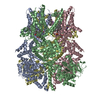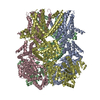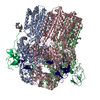[English] 日本語
 Yorodumi
Yorodumi- PDB-6nr2: Cryo-EM structure of the TRPM8 ion channel in complex with the me... -
+ Open data
Open data
- Basic information
Basic information
| Entry | Database: PDB / ID: 6nr2 | ||||||
|---|---|---|---|---|---|---|---|
| Title | Cryo-EM structure of the TRPM8 ion channel in complex with the menthol analog WS-12 and PI(4,5)P2 | ||||||
 Components Components | Transient receptor potential cation channel subfamily M member 8 | ||||||
 Keywords Keywords |  TRANSPORT PROTEIN / TRANSPORT PROTEIN /  ion channel / ion channel /  TRP channel / TRP channel /  TRPM channel / TRPM8 channel / cold sensing / lipid sensing / TRPM channel / TRPM8 channel / cold sensing / lipid sensing /  menthol / menthol /  icilin / icilin /  WS-12 / PI(4 / 5)P2 / WS-12 / PI(4 / 5)P2 /  cooling agent / cooling agent /  MEMBRANE PROTEIN / calcium-permeable ion channel MEMBRANE PROTEIN / calcium-permeable ion channel | ||||||
| Function / homology | Chem-KXP / Chem-KXS Function and homology information Function and homology information | ||||||
| Biological species |   Ficedula albicollis (Collared flycatcher) Ficedula albicollis (Collared flycatcher) | ||||||
| Method |  ELECTRON MICROSCOPY / ELECTRON MICROSCOPY /  single particle reconstruction / single particle reconstruction /  cryo EM / Resolution: 4 Å cryo EM / Resolution: 4 Å | ||||||
 Authors Authors | Yin, Y. / Le, S.C. / Hsu, A.L. / Borgnia, M.J. / Yang, H. / Lee, S.-Y. | ||||||
| Funding support |  United States, 1items United States, 1items
| ||||||
 Citation Citation |  Journal: Science / Year: 2019 Journal: Science / Year: 2019Title: Structural basis of cooling agent and lipid sensing by the cold-activated TRPM8 channel. Authors: Ying Yin / Son C Le / Allen L Hsu / Mario J Borgnia / Huanghe Yang / Seok-Yong Lee /  Abstract: Transient receptor potential melastatin member 8 (TRPM8) is a calcium ion (Ca)-permeable cation channel that serves as the primary cold and menthol sensor in humans. Activation of TRPM8 by cooling ...Transient receptor potential melastatin member 8 (TRPM8) is a calcium ion (Ca)-permeable cation channel that serves as the primary cold and menthol sensor in humans. Activation of TRPM8 by cooling compounds relies on allosteric actions of agonist and membrane lipid phosphatidylinositol 4,5-bisphosphate (PIP), but lack of structural information has thus far precluded a mechanistic understanding of ligand and lipid sensing by TRPM8. Using cryo-electron microscopy, we determined the structures of TRPM8 in complex with the synthetic cooling compound icilin, PIP, and Ca, as well as in complex with the menthol analog WS-12 and PIP Our structures reveal the binding sites for cooling agonists and PIP in TRPM8. Notably, PIP binds to TRPM8 in two different modes, which illustrate the mechanism of allosteric coupling between PIP and agonists. This study provides a platform for understanding the molecular mechanism of TRPM8 activation by cooling agents. | ||||||
| History |
|
- Structure visualization
Structure visualization
| Movie |
 Movie viewer Movie viewer |
|---|---|
| Structure viewer | Molecule:  Molmil Molmil Jmol/JSmol Jmol/JSmol |
- Downloads & links
Downloads & links
- Download
Download
| PDBx/mmCIF format |  6nr2.cif.gz 6nr2.cif.gz | 602.6 KB | Display |  PDBx/mmCIF format PDBx/mmCIF format |
|---|---|---|---|---|
| PDB format |  pdb6nr2.ent.gz pdb6nr2.ent.gz | 484.3 KB | Display |  PDB format PDB format |
| PDBx/mmJSON format |  6nr2.json.gz 6nr2.json.gz | Tree view |  PDBx/mmJSON format PDBx/mmJSON format | |
| Others |  Other downloads Other downloads |
-Validation report
| Arichive directory |  https://data.pdbj.org/pub/pdb/validation_reports/nr/6nr2 https://data.pdbj.org/pub/pdb/validation_reports/nr/6nr2 ftp://data.pdbj.org/pub/pdb/validation_reports/nr/6nr2 ftp://data.pdbj.org/pub/pdb/validation_reports/nr/6nr2 | HTTPS FTP |
|---|
-Related structure data
| Related structure data |  0487MC  0488C  0489C  6nr3C  6nr4C M: map data used to model this data C: citing same article ( |
|---|---|
| Similar structure data |
- Links
Links
- Assembly
Assembly
| Deposited unit | 
|
|---|---|
| 1 |
|
- Components
Components
| #1: Protein | Mass: 130078.453 Da / Num. of mol.: 4 / Mutation: F535A,Y538D,Y539D Source method: isolated from a genetically manipulated source Source: (gene. exp.)   Ficedula albicollis (Collared flycatcher) Ficedula albicollis (Collared flycatcher)Gene: TRPM8 / Production host:   Homo sapiens (human) Homo sapiens (human)#2: Chemical | ChemComp-KXP / ( #3: Chemical | ChemComp-KXS / ( Compound details | 1 | Sequence details | The complete sample sequence including tags and engineered mutations is the following: ...The complete sample sequence including tags and engineered mutations is the following:MATLFQVSMG | |
|---|
-Experimental details
-Experiment
| Experiment | Method:  ELECTRON MICROSCOPY ELECTRON MICROSCOPY |
|---|---|
| EM experiment | Aggregation state: PARTICLE / 3D reconstruction method:  single particle reconstruction single particle reconstruction |
- Sample preparation
Sample preparation
| Component | Name: Transient receptor potential melastatin member 8 / Type: COMPLEX / Entity ID: #1 / Source: RECOMBINANT |
|---|---|
| Source (natural) | Organism:   Ficedula albicollis (Collared flycatcher) Ficedula albicollis (Collared flycatcher) |
| Source (recombinant) | Organism:   Homo sapiens (human) Homo sapiens (human) |
| Buffer solution | pH: 8 |
| Specimen | Conc.: 0.5 mg/ml / Embedding applied: NO / Shadowing applied: NO / Staining applied : NO / Vitrification applied : NO / Vitrification applied : YES : YES |
| Specimen support | Details: 15 mA / Grid material: COPPER / Grid mesh size: 300 divisions/in. / Grid type: Quantifoil R1.2/1.3 |
Vitrification | Instrument: FEI VITROBOT MARK IV / Cryogen name: ETHANE / Humidity: 100 % / Chamber temperature: 277.15 K |
- Electron microscopy imaging
Electron microscopy imaging
| Experimental equipment |  Model: Titan Krios / Image courtesy: FEI Company |
|---|---|
| Microscopy | Model: FEI TITAN KRIOS |
| Electron gun | Electron source : :  FIELD EMISSION GUN / Accelerating voltage: 300 kV / Illumination mode: FLOOD BEAM FIELD EMISSION GUN / Accelerating voltage: 300 kV / Illumination mode: FLOOD BEAM |
| Electron lens | Mode: BRIGHT FIELD Bright-field microscopy / Nominal magnification: 75000 X / Nominal defocus max: 3000 nm / Nominal defocus min: 1250 nm / Cs Bright-field microscopy / Nominal magnification: 75000 X / Nominal defocus max: 3000 nm / Nominal defocus min: 1250 nm / Cs : 2.7 mm / Alignment procedure: COMA FREE : 2.7 mm / Alignment procedure: COMA FREE |
| Specimen holder | Cryogen: NITROGEN / Specimen holder model: FEI TITAN KRIOS AUTOGRID HOLDER |
| Image recording | Average exposure time: 60 sec. / Electron dose: 42 e/Å2 / Detector mode: COUNTING / Film or detector model: FEI FALCON III (4k x 4k) / Num. of grids imaged: 1 / Num. of real images: 4006 |
- Processing
Processing
| EM software |
| ||||||||||||||||||||||||||||||||||||||||||||||||||
|---|---|---|---|---|---|---|---|---|---|---|---|---|---|---|---|---|---|---|---|---|---|---|---|---|---|---|---|---|---|---|---|---|---|---|---|---|---|---|---|---|---|---|---|---|---|---|---|---|---|---|---|
CTF correction | Type: PHASE FLIPPING AND AMPLITUDE CORRECTION | ||||||||||||||||||||||||||||||||||||||||||||||||||
| Particle selection | Num. of particles selected: 1622434 | ||||||||||||||||||||||||||||||||||||||||||||||||||
| Symmetry | Point symmetry : C4 (4 fold cyclic : C4 (4 fold cyclic ) ) | ||||||||||||||||||||||||||||||||||||||||||||||||||
3D reconstruction | Resolution: 4 Å / Resolution method: FSC 0.143 CUT-OFF / Num. of particles: 46940 / Symmetry type: POINT | ||||||||||||||||||||||||||||||||||||||||||||||||||
| Atomic model building | B value: 100 / Protocol: RIGID BODY FIT / Space: REAL | ||||||||||||||||||||||||||||||||||||||||||||||||||
| Atomic model building | PDB-ID: 6BPQ |
 Movie
Movie Controller
Controller










 PDBj
PDBj




